Lizards, commonly known as "four-legged snakes and aunt snakes", are the collective name for a large group of squamates among reptiles. They are found around the world, with approximately 7,000 known species, ranging in size from geckos a few centimeters long to Komodo dragons three meters long. Among lizard species, some are particularly large in size. Here we will sort out the ten largest species of lizards in the world, namely Komodo dragon, water monitor, Sartorius monitor, eye-spotted monitor, ornate monitor, Nile monitor, Gurrendel's monitor, and white-throated monitor. lizard, Timor spotted monitor, and Bengal monitor lizard. By learning about these giant lizards, you'll gain a greater appreciation for their sheer size.
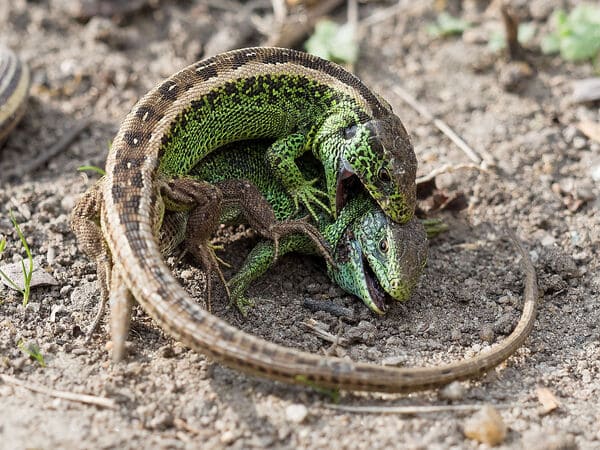
Two male agile lizards fighting
1. Komodo dragon (68-91 kg)

The Komodo dragon, also known as the Komodo dragon, is one of the largest lizard species currently known, with an average body length of 2-3 meters in the wild. The average weight of males ranges from 79-91 kg, and of females 68-73 kg. The longest Komodo dragon can reach 3.13 meters and weigh 166 kilograms (including undigested food). In captivity, they are generally heavier than their wild counterparts. These monitor lizards have tails and limbs that are almost as long as their bodies. Their limbs are almost as thick as an adult's arms, and their heads are about the size of volleyballs.
Komodo dragons are extremely aggressive and adult Komodo dragons will prey on juveniles of the same species and sometimes even attack other adults. They move extremely fast and occasionally attack humans.
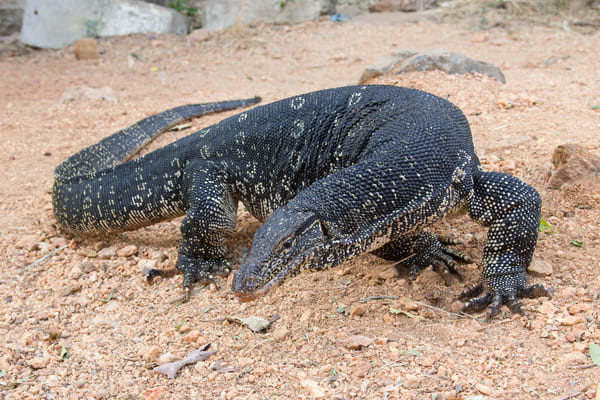
2. Water Monitor (30kg)
The water monitor lizard, also known as the five-clawed golden dragon or water gecko, is a national first-level protected wild animal in China. Among the lizard species in China, the water monitor is the largest one and the second largest lizard in the world after the Komodo dragon. Its body length can exceed 2 meters, and there is even a record of 2.7 meters in Malaysia, and its weight can reach 30 kilograms.
Although the water monitor lizard can reach up to 2 meters in length, it is extremely docile towards humans, especially children, and is not aggressive at all. There is no record of a water monitor lizard causing harm to humans worldwide, either to wild animals or domestic pets.
3. Saguaro monitor lizard (30kg)

The Sartorius monitor lizard, also known as the crocodile monitor lizard, is considered one of the longest lizards in the world, with an average body length of about 2.5 meters, its tail length is about twice the length of its trunk, and its weight can reach 30 kilograms. This monitor lizard is good at climbing rocks and trees, but its bite force and power are smaller than other monitor lizards. Despite its size, the Sartorius is the least timid of the monitor lizards and usually stays in trees or rock crevices.
There are widespread rumors about Sartorius monitor lizards, some people say they can grow up to 5-6 meters, but this is completely baseless nonsense. In fact, there are two Guinness records for the longest Sargasso monitor lizard, one with a length of 2.8 meters and the other with a length of 2.65 meters.
4. Eye-spotted Monitor Lizard (20kg)
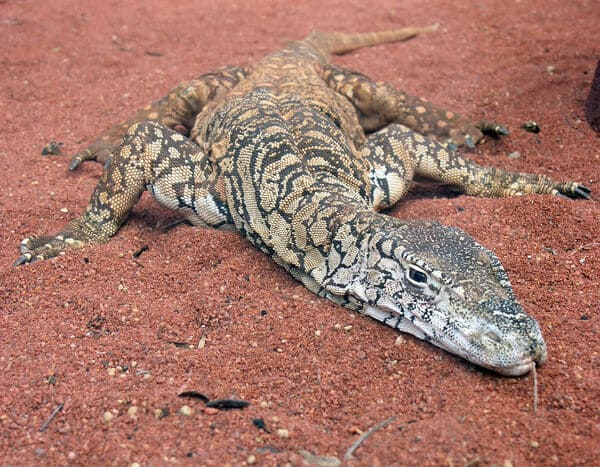
The eye-spotted monitor lizard is the top predator in the Australian desert and is mainly distributed in dry savannahs in a wide range of areas such as Queensland, Australia. This monitor lizard can be up to 2.5 meters long and weigh up to 25 kilograms, with an average body length of 2 meters and a weight of about 20 kilograms. Although their bodies are shorter, they are heavier and thicker than the round-nosed monitors, but they are more slender than the Komodo dragons or Sargasso dragons.
The eye-spotted monitor lizard is very rare in Australia and sometimes even actively avoids humans. They can run extremely fast, using all four limbs or just their hind limbs to run quickly.
5. Gorgeous monitor lizard (15-20 kg)
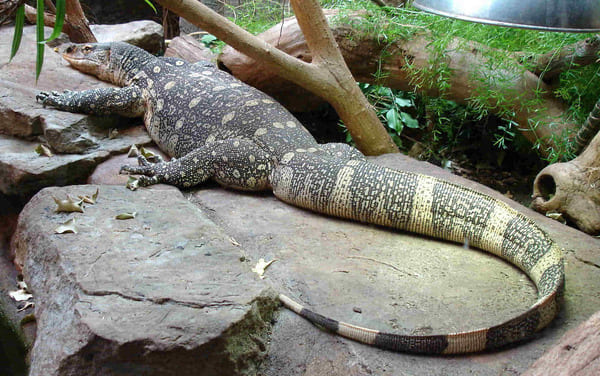
The ornate monitor lizard, also known as the West African forest monitor, is the largest lizard in Africa and one of the largest members of the African monitor lizard subgenus. Adult male ornate monitor lizards can reach more than 2 meters in length and weigh between 15 and 20 kilograms, although academic circles generally agree that the maximum length of the ornate monitor lizard is 1.9 meters. Compared with the Nile monitor lizard, the ornate monitor lizard is thicker and no longer has a slender appearance, looking very burly.
The head of the ornate monitor lizard is wide and the upper jaw is high and very thick. Its overall color scheme is mainly gray black and creamy white. Although there are some differences between individuals, there are usually only 4 to 5 rows of horizontal patterns from shoulders to thighs.
6. White-throated monitor lizard (15-17 kg)

The white-throated monitor lizard, also known as the African monitor lizard, has a total length of about 1.40 to 2 meters, and the larger individual weighs about 15 to 17 kilograms. In its early days, it was classified as a subspecies of the savanna monitor, but is now recognized as a separate species. There are four subspecies of white-throated monitor lizard: white-throated monitor lizard, Angora white-throated monitor lizard, East African white-throated monitor lizard and black-throated monitor lizard. Among them, the white-throated monitor lizard and the black-throated monitor lizard are the two more common subspecies. The white-throated monitor lizard in South Africa is called the spotted white-throated monitor lizard because of the black markings on its back. Among the four subspecies of white-throated monitor lizard, its body color is relatively conspicuous. The black-throated monitor lizard is distinguished from the other three subspecies because of its dark throat. Overall, their habits are roughly similar.
7. Bengal monitor lizard (10.2 kg)

The Bengal monitor lizard is a lizard with distinctive characteristics. Its body is covered with yellow spots, its head is triangular, its body length can reach more than 90 centimeters, its tail alone is 50 centimeters long, and its weight can reach up to 10.2 kilograms. Adult Bengal monitor lizards are generally gray or gray-green, with gray-black markings from the chin to the tail of the abdomen. These markings vary in different regions. The markings in the western region are darker, while the markings in the eastern region are lighter. Bengal monitor lizards have extremely strong survivability and can adapt to a wide range of living environments, from deserts to tropical rainforests, and can even survive and reproduce in seasonally snowy winters.
8. Monitor Lizard (9kg)
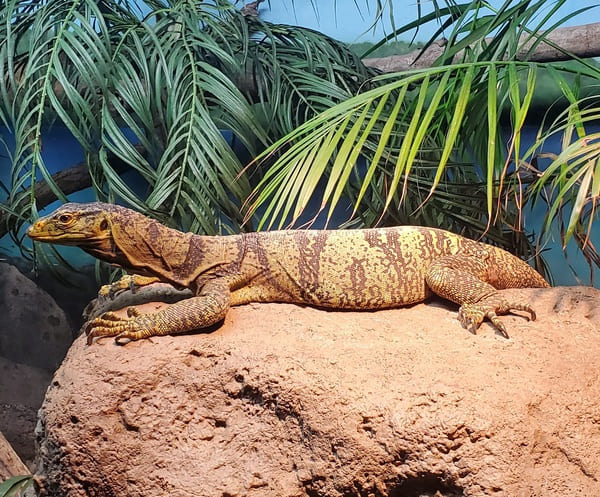
The monitor lizard is a large lizard, with a body length of about 1.75 to 2 meters and a weight of more than 9 kilograms. Their body color is usually gray, yellow-green or yellow-brown, with black annular stripes extending from the neck to the top of the tail, the lips are light yellow, and the nostrils are small and slit-shaped. The monitor lizard belongs to the family Megaridae and is mainly found in Luzon, Boliro and Catanduanes islands in the Philippines. Despite their large size, Gurren's monitors are also very fast and can quickly escape from their environment when threatened. This monitor lizard is quite common in the area.
9. Nile Monitor
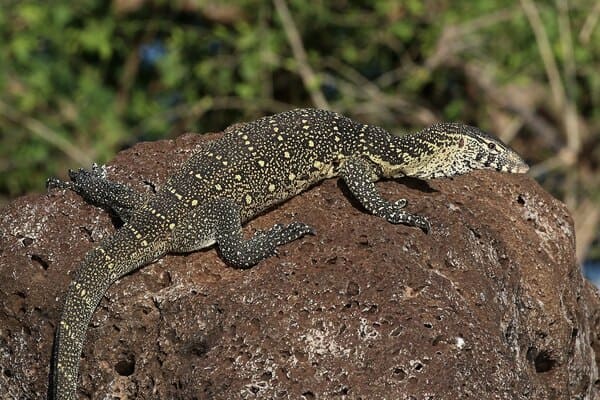
The Nile monitor is a monitor lizard distributed on the African continent, and its body length can reach 2 meters. As one of the largest lizards in Africa, Nile monitor lizards can be found in almost every corner of the African continent. In addition to deserts, they can also be found in most parts of Africa, so they are one of the most widely distributed lizards in Africa. The Nile monitor lizard has a violent and neurotic personality, is highly aggressive, and has relatively developed teeth. Its feeding habits are similar to those of ordinary monitor lizards, and its adult body size is also quite large.
10. Timor Flower Spot Monitor
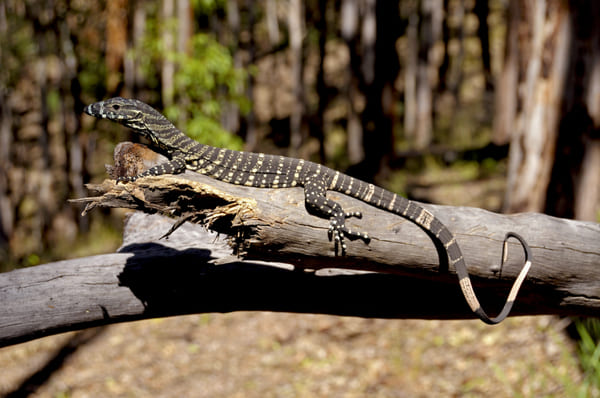
Australia's Dimor spotted monitor lizard is the second largest monitor lizard after the eye-spotted monitor lizard. Its length can reach up to 2.1 meters, but the average length is generally around 1.5 to 1.7 meters. This monitor lizard, also known as the Ornamented monitor lizard, the Red's monitor lizard or the tree monitor lizard, likes to live in humid environments, usually inhabiting waterside or wooded areas, sometimes even in the suburbs of cities. The spotted monitor lizard feeds on fish, reptiles, snails, small mammals, carrion, and even the eggs of other animals or frogs, and sometimes even the young of the same species.
The ten largest lizards in the world are mainly compiled based on Internet data. The body length, weight and habits of the relevant lizards are sorted, and the recommendations are sorted and recommended based on the weight and body length. The ranking is for reference only. If you have any questions, Welcome to comment and criticize at the end.
animal tags: lizard
We created this article in conjunction with AI technology, then made sure it was fact-checked and edited by a Animals Top editor.